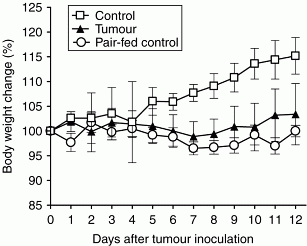ICEECE2012 Poster Presentations Adrenal cortex (113 abstracts)
Cancer induces adrenal and pituitary alterations during the development of cachexia-anorexia syndrome
T. Mazzuco , J. Crespigio , E. Fonseca , M. Macioszek , L. Lazari-Berbel , R. de Freitas & H. Souza
Universidade Estadual de Londrina – UEL, Londrina, Brazil.
Introduction: Tumour cachexia-anorexia syndrome (CAS) is a complex disorder characterized by progressive nutritional and metabolic alterations that lead to loss of muscle and adipose tissue observed in advanced-stage cancer. CAS indicates unfavourable prognosis, regardless of cancer type. Under the influence of permanent aggression, we have evaluated the effects of the cancer cachexia development on the hypothalamic-pituitary-adrenal (HPA) axis.
Methods: Experimental cancer CAS was induced by subcutaneous inoculation of the Walker-256 carcinosarcoma cells in Wistar rats. Histopathology, functional and nutritional parameters were studied in tumour-bearing rats, compared with paired feeding or free-fed control rats (PBS inoculation). Adrenals and pituitary weights were corrected for body weights.
Results: The onset of the anorexia and body weight reduction was observed from the 5th day in the tumour group (Fig. 1), followed by gradual catabolic changes. Although pair-feeding decreased body weight, it did not affect body mass index; both control groups were similar at necropsy. On days 5 and 12 after tumour inoculation, cachexia index (%) was 10.3(±1.2) and 14.7(±0.9), respectively. In the tumour group, adrenals and pituitary weighed 2.25-fold(±0.15) and 2.17-fold(±0.5) greater than control on day 5, respectively. On day 12, adrenals and pituitary weight significantly decreased to 1.62(±0.09) and 1.45(±0.08) fold change from control, respectively. Adrenal cortex of rats with cancer CAS exhibited hypertrophy of the zona fasciculata; mean cortical width measured 1.22(±0.04) and 1.13(±0.03) mm on days 5 and 12, respectively (control, 0.92±0.02, P<0.001). After acute stimulation of tumour-bearing rats (12 days) with supraphysiological doses of exogenous ACTH, plasma corticosterone levels was 146.7±18.3, while the normal response in control rats was 193.3±21.3 (P<0.01).
Conclusion: Adrenal and pituitary undergo morphological alterations during the development of cancer CAS indicating the HPA axis activation. Results suggest a biphasic adaptive response to cancer as stressful aggression, which starts before the day 5 of tumour inoculation.

Declaration of interest: The authors declare that there is no conflict of interest that could be perceived as prejudicing the impartiality of the research project.
Funding: This work was supported, however funding details unavailable.




